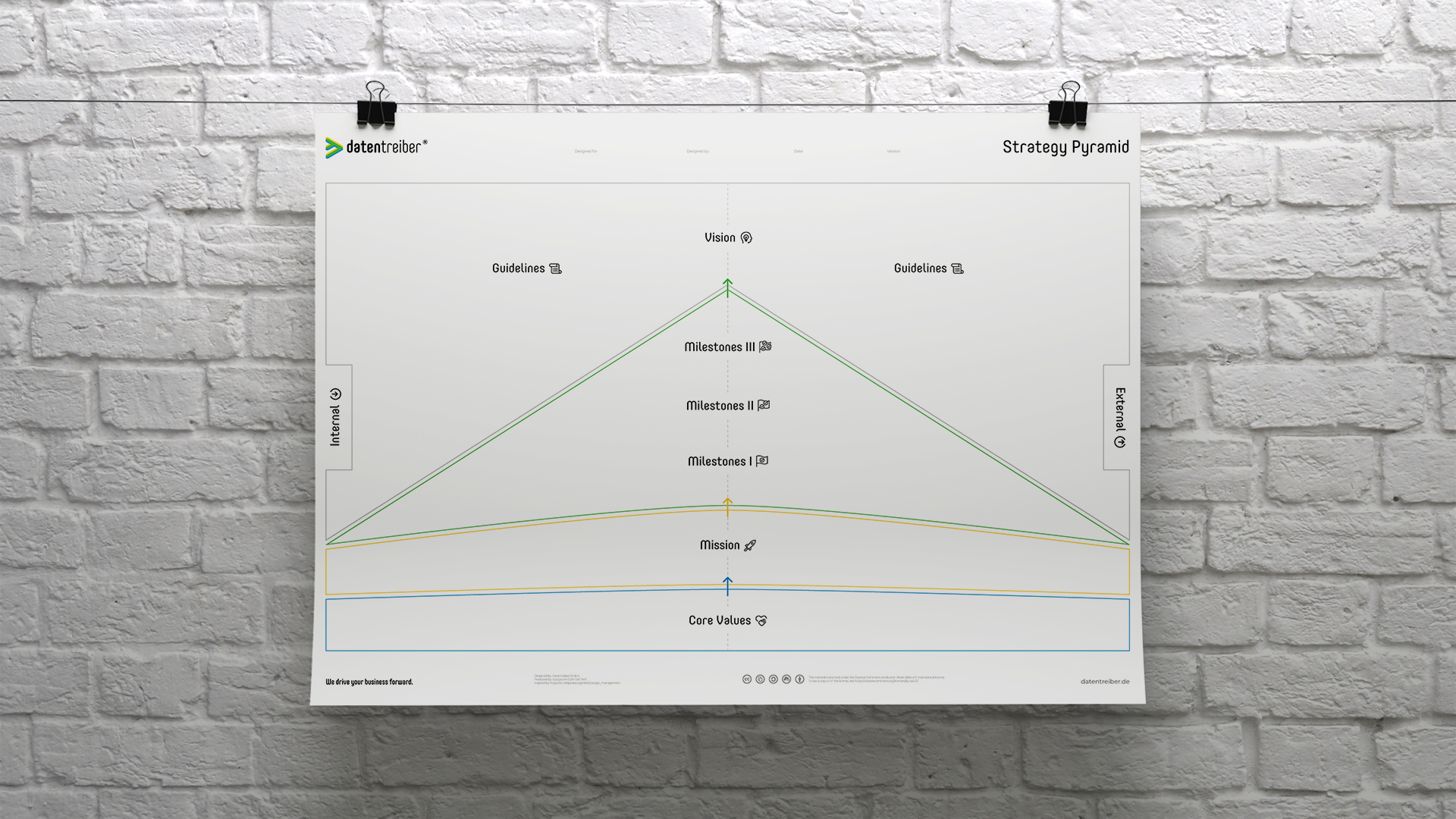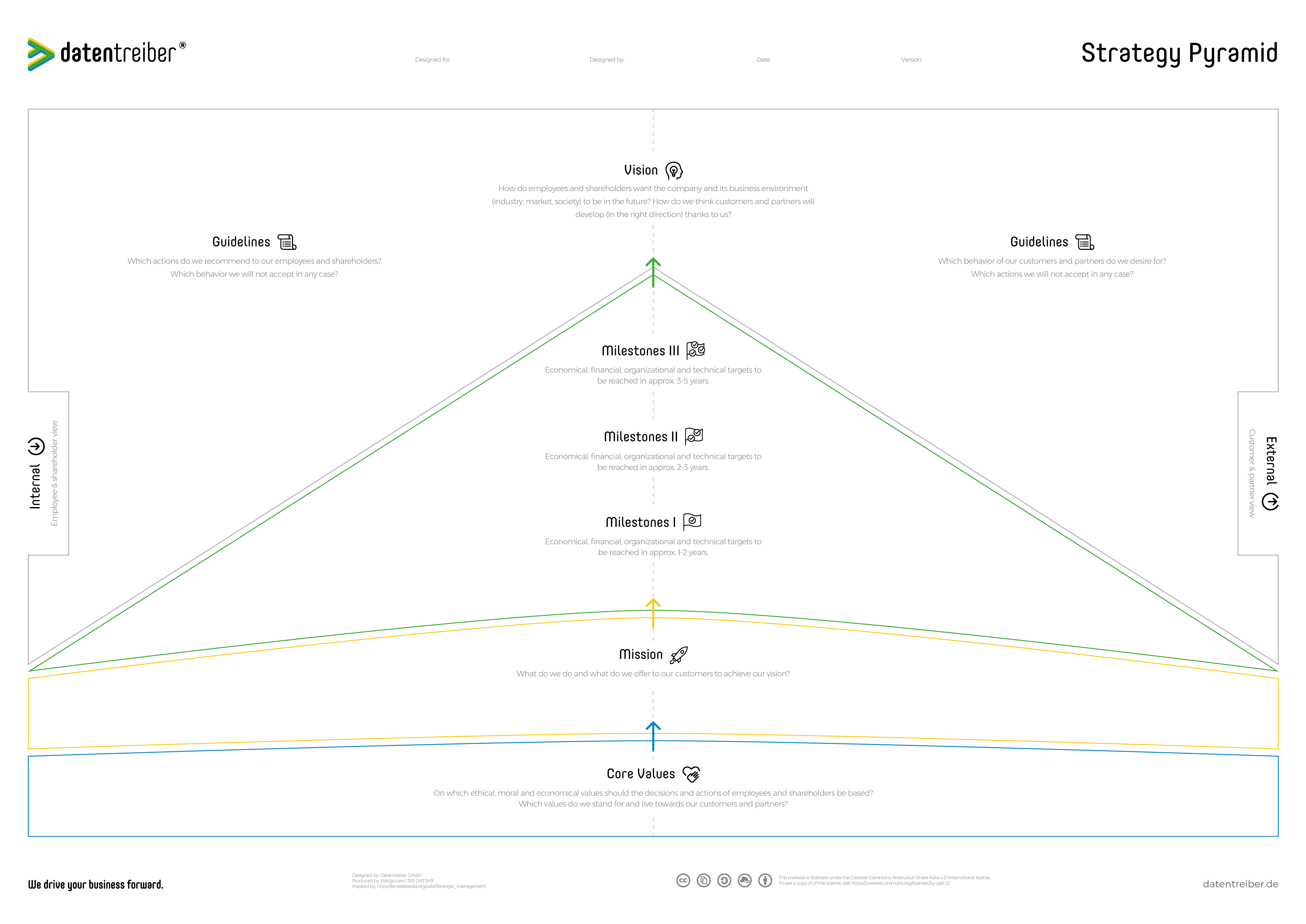
Strategy Pyramid Canvas
Using the Strategy Pyramid Canvas you can develop a common corporate strategy in collaboration with your team to reach your objectives together. It assists you to find the right objectives and path for your company.
We drive your business forward.
What Is the Strategy Pyramid Canvas?
A successful corporate strategy helps you to do the right things. Talking about success largely depends on the acceptance of the contributing people. Hence these should be part of finding the objectives and the path towards them. The Strategy Pyramid Canvas is a collaboration tool that concretizes and visualizes the essential parts of a corporate strategy:
- The Vision describes the company’s desired target state, its customers and its surroundings (industry, economy, society etc. ).
- Whereas the Mission determines the path towards the vision: what do we do and offer to make the vision come true?
- The Core Values make up the fundament of the company and provide footing in difficult situations.
- The Guidelines provide orientation and concrete recommended course of action how the vision needs to be fulfilled based on the mission.
- The Milestones represent intermediate steps towards reaching the vision and help to decide if you are on track.
The Strategy Pyramid Canvas is available for free under a Creative Commons license: you may use and modify the canvas as long as you cite Datentreiber in particular as the source.
We drive your business forward.

We drive your business forward.
How Do I Use the Strategy Pyramid Canvas?
The Strategy Pyramid helps you to develop a common vision and mission together with your team. Furthermore, it also facilitates defining the guidelines and milestones necessary to reach your objectives. The common core values serve as a starting point throughout the process. Further, the Strategy Pyramid allows you to differentiate between the internal perspective (employee and shareholder view) and the external perspective (customer and partner view).
For more information, see Data Strategy Design.
Start
In order to define a corporate strategy, it’s important to involve all decision-makers as well as all other stakeholders who are directly involved in the strategy’s implementation. These are, for example, shareholders, managing directors, senior management, and employees‘ representatives. Start with a joint workshop, preferably facilitated by an independent, for example, an external moderator, using this Strategy Pyramid Canvas. The workshop’s objective is to develop a common understanding of the company’s objective, the right direction, and the shortest path to reach the objective. By reaching consensus and clarity in the team regarding the strategy, you ensure the support of your shareholders, employees, partners, and customers as well as the understanding of the whole team.
Step 1 of 5
Core Values
Start with the core values: which ethical, moral, social, or economical values does your team stand for? What’s important to you? First, collect proposals and let the workshop’s participants tell examples in which a core value helps to solve a conflict and leads to a decision based on the value. Let the team discuss the values afterward and subsequently select those values on which the team agrees. As an option, you can also think about catchy slogans for each of the values.
Questions:
- For which ethical, moral social, and economical values do your employees and shareholders personally stand for?
- Which values drive your everyday actions and objectives in business?
- Which values provide you with orientation when facing critical questions or conflicts?
- For which values you can find consensus between all your employees and shareholders?
- According to which values do your employees and shareholders want to live by?
Step 1 of 5
Examples:
- Transparency in decisions
- Honesty between employees
- Binding commitments
- Fairness in negotiations with customers and partners
- Excellence in all tasks
- Focus on profitability
- Sustainability in operations
Examples of slogans:
- “Think big, start small.”
- “Fail early to succeed sooner.”
- “Done is better than perfect.”
- “Walk the talk”
Step 2 of 5
Vision
Next, develop a common vision for your company. A vision is drawing a positive picture of your company in the future. It describes the long-term state of your company as well as the environment which it should influence in a positive way (for example the industry, the market, the whole economy, or even the whole society). Start again by collecting ideas, then discuss them and finally select those ideas on which your team can agree on and which are consistent with each other. Afterward, you can formulate a vision statement that expresses all selected ideas in one sentence.
Questions:
- What makes your company important (in the future) – for your customers, partners, employees, shareholders?
- What makes your company’s existence significant in your industry, market or even the whole economy or society?
- Where and how do you see your company in the future?
- What is the ideal state regarding your company’s environment which it can influence?
Step 2 of 5
Examples:
- Market and technology leader for predictive analytics solutions targeted at medium-sized mechanical engineering businesses in Germany
- Artificial Intelligence in every software and hardware
- Every household has its own domestic robot
Examples of vision statements:
- Adobe: “To move the web forward and give web designers and developers the best tools and services in the world”
- Harley Davidson: “To fulfil dreams through the experiences of motorcycling.”
- Netflix: “Helping content creators around the world to find a global audience.”
- Paypal: “The web’s most convenient, secure and cost-effective payments solution.”
Source: executestrategy.net
Step 3 of 5
Mission
The mission is to make the vision concrete. It answers the question of how you want to achieve the target state of your company, the market, the economy, or the society. A mission is a positive stimulus targeting internal as well as external stakeholders to implement the strategy, support the company and follow the vision.
Questions:
- How do you want to achieve your vision?
- Which impact should your company have?
- Which is your company’s offering towards your customers?
- Why should your employees be committed to your company?
- Why should shareholders invest in your company?
- Why should your partners support your company?
Step 3 of 5
Examples:
- Predict service interruptions with a 99,9% accuracy before their occurrence.
- Make the development of AI applications accessible to everyone.
- Make domestic robots as low priced and reliable as personal computers.
Examples of mission statements:
- Doctors without Borders: “Doctors without Borders works in nearly 70 countries providing medical aid to those most in need regardless of their race, religion, or political affiliation.”
- Google: “Google’s mission is to organize the world’s information and make it universally accessible and useful.”
- Starbucks: “Our mission: to inspire and nurture the human spirit – one person, one cup and one neighborhood at a time.”
Source: wiseCom
Step 4 of 5
Milestones
Milestones operationalize the mission and define for various timeframes the goals to be reached. Milestones may for example quantify the number of employees and revenue or schedule product developments and financing rounds. They act as landmarks for employees regarding the strategy’s correct implementation as well as checkpoints for shareholders regarding the strategy’s effectiveness.
Questions:
- How much revenue and profit do we want to make in X years?
- How many customers do we want to serve in X years?
- How many employees do we want to hire until X?
- When should product X launch?
- When do we want to close financing round A?
- How high should our company’s value be on (point in time) X?
- When do we want to expand to X?
Examples:
- 250.000 € revenue and 25.000 € profit in the third year
- 5 employees after the first year
- The real-time dashboard product launches in the second year
- A valuation of 10 million Euros and an investment of 2.5 million Euros after 3 years
Step 5 of 5
Guidelines
Guidelines should guide your company to your vision. They do so by recommending actions which in turn lead to reaching the milestones. Guidelines answer the question of what you need to do in order to reach the goals set. Guidelines are no directives. Under certain circumstances, they can be bypassed but this should rather be the exception so that your company does not derail from its path and stays in the right direction.
Questions:
- What do we want to offer to our customers and what do we not want to offer?
- Which freedoms do we want to provide our customers with and where do we want to draw a red line?
- What do we expect from our partners in a positive as well as in a negative sense?
- Which rights and duties do our shareholders have?
- To what extend do we want to give management control to our shareholders regarding our operative business?
- On what do we want our employees to focus on?
- Which decisions are our employees allowed to take on their own?
Examples:
- Focus on analytics projects. No software projects.
- Customer is king but our employees are no servants.
- Being proactive partners at eye level and not only order takers.
- Shareholders are counselors, no decision takers.
- Employees should independently eliminate tasks, automate them or delegate them.
Completion
As a very last step, take some time to critically reflect on the Strategy Pyramid:
- Are there any conflicting core values?
- Are your vision, mission, guidelines and milestones consistent with your core values?
- Are your milestones realistic in accordance with your vision and mission?
- Are the guidelines consistent? Are they defined narrow enough to guide your team, but with enough freedom to not limit its flexibility?
- Are the internal and external perspective consistent with each other?
If necessary, rework your strategy until it’s clear, consistent, and finds consensus among all. Question your strategy on a regular base for example in yearly strategy workshops. The core values should remain comparatively stable as they are the fundament which should only be changed in case there are good reasons for doing so, for example, major conflicts between the stakeholders. Additionally, you should avoid changing the vision and mission prematurely or too frequently. This can lead to insecurity among your employees, shareholders, customers, etc. Rather consider if your milestones (intermediate objectives) have been set in the right way (for instance too or too little ambitious) and if your guidelines really guide you towards your objective (vision), or if they rather distract you.
In the beginning, when starting out with your company, you can experiment. However, in the course of time, the experience gained from these experiments should be reflected in more narrow guidelines. Keep the findings of what worked and what didn’t, with respect to implementing your vision, as part of your guidelines. The guidelines help your company to focus on its vision.
We drive your business forward.
Where Can I Find More Information?
Here you can find further documentation:
Data Thinker Group (LinkedIn)
We drive your business forward.
How Can I Start?
Seminars

Get to know our Data Strategy Design Method in our practical seminars:
- For beginners: Data Strategy & Culture
- For rising stars: Data Design Thinking
- For advanced designers: Data Business Consulting
Cross References

Here you can find further canvas and information concerning Data Strategy Design:
License Terms

You are free to:
Share — copy and redistribute the canvas in any medium or format
Adapt — remix, transform, and build upon the canvas
for any purpose, even commercially.
Under the following terms:
Attribution
ShareAlike
We drive your business forward.
Subscribe to our newsletter:
Receive all relevant blog articles, new seminar dates, special conference offers and much more conveniently by email. As a welcome gift, we will send you a link to download our Datentreiber design book (in German) and, for a short time, the article ” Data Thinking: mehr Wert aus Daten” in PDF form after your registration.
By clicking ‘Subscribe to our newsletter’ you agree that we process your information in accordance with our privacy policy.


